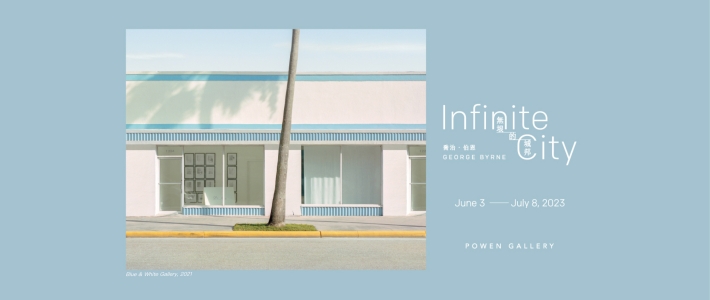喬治.伯恩:無垠的城邦

主辦人/單位:
紅野畫廊 Powen Gallery
活動類別:
展覽
首次展演日期:
2025-10-22
結束展演日期:
2023-07-08
詳細時間說明:
6/3 (六) — 7/8 (六),10:00 — 19:00,週日及週一休館 Closed on Sundays & Mondays
活動地點:
紅野畫廊
活動地址:
台北市中山區松江路164巷11號
喬治.伯恩:無垠的城邦
George Byrne: Infinite City
Artist|喬治.伯恩 George Byrne
Duration|June 3 – July 8, 2023
Venue|紅野畫廊 Powen Gallery(台北市中山區松江路164巷11號,10:00-19:00 週日及週一休館 Closed on Sundays & Mondays)
喬治.伯恩的Wonderland
文|藍仲軒 LAN Chung-Hsuan(藝術家 / 策展人)
自尼塞福爾.涅普斯(Nicéphore Niépce)在1826年拍攝了史上第一張照片、路易.達蓋爾(Louis Daguerre)在1839年確立了攝影術之後,攝影的可能性不斷地被擴張,直到今日亦然。從得以操控真實的新聞攝影、黑暗獵奇的私攝影到觀念藝術中的影像運用、隨處可見的手機攝影,攝影的科技、思想、經營在普及的同時,也不斷地在目的化與複雜化。
在攝影術出現與攝影氾濫之間,曾有那麼一段時間,攝影不只是單純記錄了迅速成長的工業城市樣貌,也更可貴地表述了城市的氛圍:尤金・阿傑(Eugène Atget)的老巴黎及阿爾弗雷德・施蒂格利茨(Alfred Stieglitz)的舊紐約,在實的見證之外,虛的情感穿透了瞳孔,直搗我們的精神。這樣的攝影狀態(即使街頭攝影、旅遊照片、新聞紀實也不斷的捕捉城市,但那種毫無內化、標準視覺的攝影作品並不在此列),我們似乎可以在澳洲攝影藝術家喬治.伯恩(George Byrne)所拍攝的洛杉磯作品中,找到一種當代的共鳴。
洛杉磯,因其地中海型氣候特性而擁有著充分而適當的陽光,也造就了該城獨有的銳利光影。來自雪梨的喬治.伯恩在2011年移居洛杉磯,有效地利用了洛杉磯的氣候特色,並在發展出一系列極具代表性與辨識度的城市攝影。幾何方塊的構圖、硬挺建物與圓潤植物、強烈卻又安撫的色彩、與視線巧妙互文的標誌、帶有節奏的光影與物體-乍看之下,這些作品彷彿一幅幅精準設計的復古海報,炫耀著一座海濱城市的風光明媚。即便如此,當近看到牆面的瑕疵與油漆的紋理時,我們才會發覺這些街景是多麽充滿人性。
當洛杉磯的人類氣息不斷地被大眾文化放大時,伯恩卻刻意的排除掉了人。好萊塢、嘻哈、海灘、多元文化,所有我們熟知的洛杉磯片段被藝術家統一分解,再灌輸回了作品街角中的每個色塊。即使作品中偶爾出現了人,也絕非比佛利山莊的招牌式花枝招展,即伯恩不意圖拍攝高貴地段,也不高傲地批判地緣關係。所以伯恩的作品與人真的沒有關係嗎?恰好相反,藝術家正是代表著「人」的變因。
前文提及了被攝物是如何提醒了人性,而當我們緩過神來,才會發現街道缺少了生活痕跡。其實,這些都是被建構出的「完美」,是伯恩透過觀察、尋找、收集、計畫而拼貼出來的場景,充滿了藝術家的細膩意識,而非偶一為之的趣味。在驚覺如此的創作手法後,我們或許會急於撇清他與阿傑、施蒂格利茨的關聯,也或許會想在新地景攝影(new topographics)、超現實主義(surrealism)、觀念藝術(conceptual art)、普普藝術(pop art)之中為其安插一個藝術脈絡。
然而過多的理性剖析,或許會削弱感官的純粹性與觀看的直覺性。於2023年大量出現的人工智慧藝術(artificial intellegence art)已經能生成許多城市影像,並具有高度準確性。大多數的時候,我們不會深究其取樣從何而來,甚至能享受其中的誤差。那麼伯恩半虛構的洛杉磯,跳脫了攝影對真實的一廂情願。也就是說,喬治.伯恩的洛杉磯將不是文獻證據,而是綿延在你我心中的自由與繽紛之都。那彷彿一種清澈的平行時空,其作用也逐漸明顯了起來:是藝術家所打造的一座移除當代紛擾的「wonderland」,而如此的風景,我們都期待在下一個路口遇見。
—
George Byrne: Infinite City
Artist | George Byrne
Duration | June 3 – July 8, 2023
Venue | Powen Gallery(No. 11, Lane 164, Songjiang Road, Zhongshan District, Taipei City, Taiwan 10459 / 10:00-19:00 Closed on Sundays and Mondays)
George Byrne’s Wonderland
Written by LAN Chung-Hsuan (Artist / Curator)
Ever since the first photograph taken by Nicéphore Niépce, and the devising of Daguerreotype—a method established by Louis Daguerre, the possibility of what photography could be has been expanding: from the fact-manipulating photojournalism; to the dark and outlandish shi-shashin (私写真); to the diverse utilization of images in conceptual art; to the ever-so-ubiquitous smart phone snapshots. The more popular the technology, credos and methodologies of photography get, the more complicated becomes the question of how photography as a medium today can still serve as a means to our ends.
Between the emergence of Daguerreotype in the 1840s and the prevalence of photography today, was an industrial period, during which not only was the scene of urbanization documented by photography, but also the atmosphere of the metropolitan. The works of Eugène Atget’s old Paris and Alfred Steieglitz’s old New York served as the perfect examples of this, where beyond the visual presentation of each cityscape, the aura of the cities to this day still beams through our retinas and goes into our core. The similar effects of such way of photography (despite the fact that street photos, traveling photos and photojournalisms also captured the urban scene, the unprocessed, uninternalized, and standardized processes are not included in this context) can be found in the Australian photographer George Byrne’s photo collages of Los Angeles.
Los Angeles, blessed by the Mediterranean climate with ample sunlight, is known for a sort of harsh lighting particular to the city. George Byrne moved to Los Angeles from Sydney in 2011. Taking advantage of the unique climate in Los Angeles, Byrne developed a series of images that are highly distinctive in style and representative of the city through: the geometric compositions; sturdy buildings and luscious botanicals; the harsh but comforting colors; the cleverly intertextual signs; the rhythmic arrangements of shadows and lights. Upon first impression, these images, showing off the oceanic brightness that the city of angels has to offer, present themselves as meticulously designed retro-posters. Despite their glossy surfaces, the textures of the oil on the walls and their damages slowly become noticeable upon closer examination. The artificiality within these images unveils itself.
Byrne deliberately excluded humans from his works at a moment in time when human’s presence in Los Angeles is endlessly emphasized in our pop culture, Hollywood, Hip-hop, Cali-beaches, multiculturalism—each fragment of Los Angeles we are familiar with, in Byrne’s work is deconstructed and then pieced back together into the same image. When humans do make their rare appearances in Byrne’s works, they are never presented in forms of pure extravagance that is Beverly Hills. Byrne does not eagerly seeks out site and signs of higher class nor does he seem to care for an arrogant take down of the urban site geo-relationality. So, do Byrne’s works really have little to do with humans? On the contrary, the artist himself is the missing link in these photos.
We have touched on in previous paragraphs how Byrne’s photographed objects reminds us of the presence of human, how the direct traces of human lives are missing from the streets, and that perfection is a deliberate construction. Each fragment included in these images, was the result of Byrne’s observation, his actively seeking out, collecting and planning out the pieces. They are by no means accidental.
Upon this realization, perhaps we find ourselves inclined to deny the artistic connection between him, Atget and Steieglitz, and we find ourselves wanting to preserve a place for Byrne between the new topographics, surrealism, conceptual art and pop art. Nonetheless, excessive rational analysis weakens the intuitive response of the senses. In 2023, where Artificial Intelligence is fully capable of following instructions and generating images of cityscapes with a precision so indelible that we don’t often question which samples these images were made from. From time to time, we even find ourselves enjoying the little errors that occur.
To conclude, George Byrne’s semi-mythologized Los Angeles, was created from a place of detachment, of photography as a medium from its conventional demand of raw documentation. Byrne’s Los Angeles, by no means a real depiction of the actual city, radiates the energy of a city full of freedom and bright colors. A city that exists in a universe parallel to our own. Photography’s end for Byrne, therefore, becomes self-evident: to construct a wonderland far removed from the messiness of urban sites, within which we anticipate the arrival of such ideal at the next corner.
費用說明:
免費入場
活動聯絡電話: 02-25236009 活動聯絡人: Aurelia







